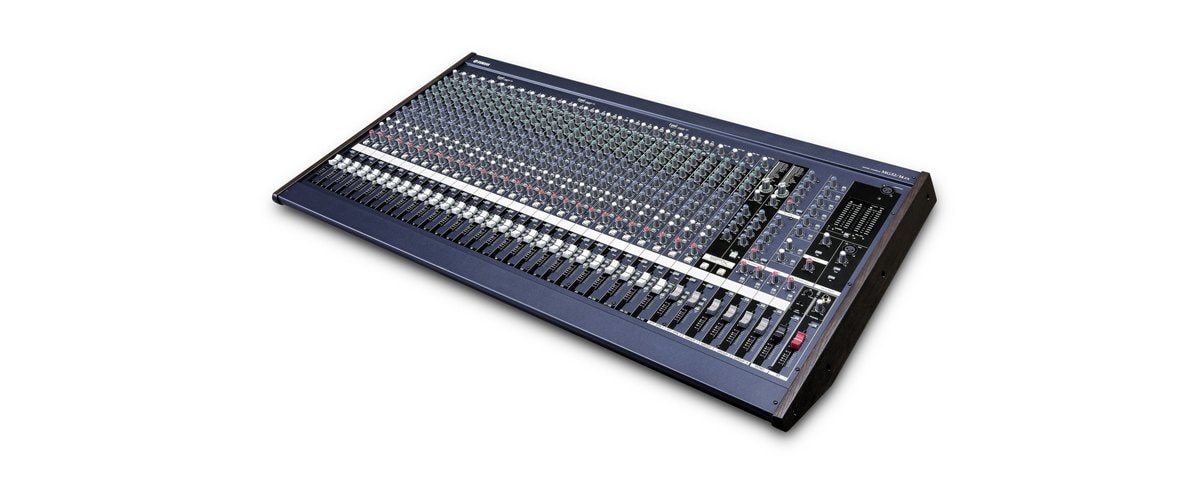MG32/14FX, MG24/14FX
Serious Consoles for Live Sound or Installations
The MG24/14FX and MG32/14FX are full-featured sound reinforcement consoles with capacity and capabilities that can handle demanding live sound applications. Choose the 24-input MG24/14FX or 32-input MG32/14FX according to the number of sources you need to handle. All other features are the same, including two renowned Yamaha SPX effect processors built in. Extensive routing capability is also provided for monitoring and external signal processing, as required by your application.
High Input Capacity for Live Sound
The MG24/14FX has 16 mono inputs and 4 stereo inputs, while the MG32/14FX has 24 mono inputs and 4 stereo inputs. Input gain controls and pad switches allow optimum matching with the widest possible range of sources: microphone levels can be adjusted from -60 dB to +10 dB, while line levels can be adjusted from -34 dB to +10 dB. Channel peak indicators are provided to facilitate optimum level matching.
Versatile Inputs
The monaural inputs provide both balanced XLR and phone jacks - that's channels 1 through 16 on the MG24/14FX, and channels 1 through 24 on the MG32/14FX. Two of the stereo inputs offer phone jacks as well as RCA pin jacks. Independent 2-track RCA pin jack inputs are also provided for input from CD players or other stereo line-level sources.
Top-quality Microphone Preamps
Microphone preamplifiers play a vital role in determining the final sound of your mixes. The MG-series mixers feature low-noise, high-performance microphone preamplifiers that will bring out the best in dynamic and condenser type microphones. Microphone preamplifiers are provided on channels 1 through 16 of the MG24/14FX, and on channels 1 through 24 of the MG32/14FX.
Switchable Phantom Power
The MG mixer microphone preamplifiers provide 48-volt phantom power for studio-quality condenser microphones. Phantom power can be switched on or off for in 8-channel groups.
Insert I/O
Mono input channels feature insert patch points that can be used to insert external signal-processing devices into the channel's signal path. Insert I/O points are also provided on the stereo bus (L and R) and on the four group buses.
Mid-sweep 3-band Mono Channel EQ, 4-band Stereo Channel EQ
The mono channels on both the MG24/14FX and MG32/14FX offer advanced EQ facilities: 3-band EQ with a 10 kHz shelving HIGH control, a 250 Hz ~ 5 kHz sweepable MID control, and a 100 Hz shelving LOW control. The microphone inputs also have switchable 80 Hz high-pass filters for low-frequency noise reduction. The stereo channels feature 4-band EQ with 10 kHz HIGH, 3 kHz HI MID, 800 Hz LO MID, and 100 HZ LOW controls.
Multi-bus Configuration with a Total of 14 Buses
In addition to the main stereo bus that feeds the console's main outputs, the MG24/14FX and MG32/14FX feature four group buses for convenient sub-mix grouping, six auxiliary buses for monitoring and external effect send, and send buses for the two internal effect processors. That's a total of 14 buses in all for exceptionally flexible signal routing. The channel send knobs and bus assign switches make it easy to send the signal from each channel to the stereo, group, internal effect, and auxiliary buses as required.
Ample Sends and Returns
All input channels have a total of six auxiliary sends: AUX send 1 through 4 can be switched for pre- or post-fader operation, while AUX sends 5 and 6 are post-fader. Two EFFECT sends are provided in addition to the six AUX sends. That's more than sufficient send capability to handle monitoring and effects for all but the most complex applications. Two stereo AUX returns are provided in addition to the internal effect returns, providing an extra margin of return versatility for wet monitoring, for example.
Comprehensive Output Connectors
The mixer's main stereo program signal is simultaneously delivered to the main stereo outputs (XLR jacks), the sub-stereo outputs (phone jacks), the REC OUT connectors (RCA pin jacks), the mono out (XLR jack), and the headphones output (stereo phone jack). Independent phone-jack outputs are also provided for group buses 1 through 4. So even if you need to feed a front-of-house system, monitors, a subwoofer, a master recorder, and other output lines simultaneously, the MG24/14FX or MG32/14FX will handle it.
Reliable XLR Output Connectors
The main stereo outputs and mono output feature rugged, reliable XLR type connectors. Not only do these connectors lock to minimize the chance of accidental disconnection, but they provide superior electrical contact for long-term dependability as well.
Variable LPF on the Mono Output
A low-pass filter with a roll-off frequency that can be varied from 80 to 120Hz is provided on the mono output for convenient connection and optimum matching with a subwoofer.
12-segment Level Meters
Four high-visibility 12-segment meters are switchable to allow precise visual monitoring of levels on the main stereo bus, the four group buses, the stereo 2-track input, the PFL (Pre-Fader Listen) bus, or the AFL (After-Fader Listen) bus.
High-performance Digital Effect Processors Built In
Both the MG24/14FX and MG32/14FX contain a powerful pair of Yamaha digital signal processors that provide a useful selection of 16 advanced digital effects. Effect programs include reverb, delay, pitch change chorus, phaser, voice doubler, and distortion. The effects include editable parameters so they can be customized as required, and processor "B" even has a TAP switch for real-time tap-tempo entry. With these top-performance effect processors built in, you wont have to transport and set up racks of external effects to create your sound.
Illuminated Switches for High Visibility
The channel ON switches, PFL (Pre-Fader Listen) switches and phantom power switches are original Yamaha illuminated types, so it's easy to visually check vital console settings.
Talkback for Convenient Communication
A talkback microphone input is provided for easy, efficient communication between the sound engineer and musicians and staff in live-sound applications, during setup, rehearsal, and the actual performance.
Intuitive Controls and High Reliability
The design of the faders, rotary controls and switches used on the MG mixers, as well as the way they are laid out, allow easy operation and visual confirmation of settings.








